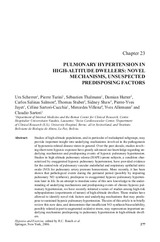Pulmonary hypertension in high-altitude dwellers : novel mechanisms, unsuspected predisposing factors
Date
2006Author
Scherrer, U
Turini, P
Thalmann, S
Hutter, D
Salinas Salmón, C
Stuber, T
Shaw, S
Jayet, PY
Sartori-Cucchial, C
Villena, M
Allemann, Y
Sartori, C
Metadata
Show full item recordAbstract
Abstract
Studies of high-altitude populations, and in particular of maladapted subgroups, may provide important insight into underlying mechanisms involved in the pathogenesis of hypoxemia-related disease states in general. Over the past decade, studies involving short-term hypoxic exposure have greatly advanced our knowledge regarding underlying mechanisms and predisposing events of hypoxic pulmonary hypertension. Studies in high altitude pulmonary edema (HAPE)-prone subjects, a condition characterized by exaggerated hypoxic pulmonary hypertension, have provided evidence for the central role of pulmonary vascular endothelial and respiratory epithelial nitric oxide (NO) for pulmonary artery pressure homeostasis. More recently, it has been shown that pathological events during the perinatal period (possibly by impairing pulmonary NO synthesis), predispose to exaggerated hypoxic pulmonary hypertension later in life. In an attempt to translate some of this new knowledge to the understanding of underlying mechanisms and predisposing events of chronic hypoxic pulmonary hypertension, we have recently initiated a series of studies among high-risk subpopulations (experiments of nature) of high-altitude dwellers. These studies have allowed to identify novel risk factors and underlying mechanisms that may predispose to sustained hypoxic pulmonary hypertension. The aim of this article is to briefly review this new data, and demonstrate that insufficient NO synthesis/bioavailability, possibly related in part to augmented oxidative stress, may represent an important underlying mechanism predisposing to pulmonary hypertension in high-altitude dwellers

